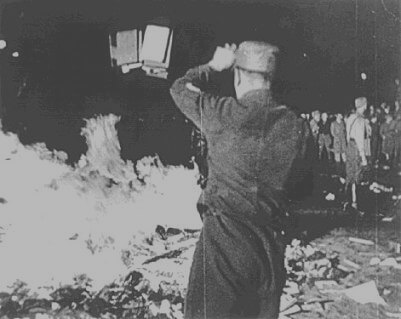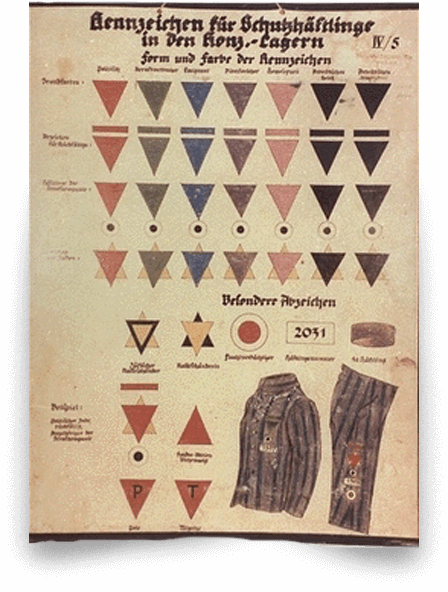Intro
The Nazi regime increases the severity of the law in the Netherlands: homosexuality is now seen as a threat to the public. A mere suspicion can lead to arrest and prosecution. The little-known fate of homosexuals in the Netherlands is told here through the stories of 5 men and 1 woman. Many of them were in the Resistance. Some were Jewish. All were lesbian, gay or bisexual.
Read the stories of:

The homosexual ‘contamination’
explained graphically.
Nazi-Germany and homosexuality
Germany had a thriving gay movement with clubs, pubs and magazines before the rise of the Nazi regime. But there were also a lot of (conservative) opposing forces. They felt supported by section 175 of the German Criminal Code. This section stated that homosexual contact was forbidden between men. There was even a penalty of up to five years.
After the Nazis seized power homosexuals were regarded as enemies of the state. They argued that gay men and lesbians had to be prosecuted because they weren’t able to produce children and that they could ‘tempt’ young people into homosexuality. Also the supposed on-masculinity and the fear of groups played a role.
Read moreAfter the Nazis seized power homosexuals were regarded as enemies of the state. They argued that gay men and lesbians had to be prosecuted because they weren’t able to produce children and that they could ‘tempt’ young people into homosexuality. Also the supposed on-masculinity and the fear of groups played a role.
Men who were arrested under section 175 were mostly Germans or Austrians. In the occupied countries, the Germans used other methods. The police in those countries were often already hostile to gay men and women and kept lists of homosexuals. Usually homosexuals were arrested for other reasons such as resistance activities but because of their sexuality they were already under the attention of the police. They weren’t systematically sent to camps or correctional facilities, they often ended up in prison under local law. Jewish homosexuals formed an exception; they were treated roughly like other Jews.
Men who were arrested under section 175 were mostly Germans or Austrians. In the occupied countries, the Germans used other methods. The police in those countries were often already hostile to gay men and women and kept lists of homosexuals. Usually homosexuals were arrested for other reasons such as resistance activities but because of their sexuality they were already under the attention of the police. They weren’t systematically sent to camps or correctional facilities, they often ended up in prison under local law. Jewish homosexuals formed an exception; they were treated roughly like other Jews.
Transgenders
In 1919, partly due to the German doctor and sexologist Magnus Hirschfeld (1868 – 1935), the ‘Institut für Sexualwissenschaft’ (Institute for Sexual Science) was founded in Berlin. The rather progressive institute organized sex education and did research. It was also a global pioneer in the acceptance of homosexuality. The founder Hirschfeld was the first to come up with the term ‘transsexual’.
Because the Nazis wanted to ban homosexuality from public life, they decided in 1933 to close down many meeting spots and the distribution of several magazines were stopped as well. In May 1933, the 20.000 books and magazines owned by the library of the Institut für Sexualwissenschaft were all burnt at the stake. Magnus Hirschfeld managed to get away because at the time he was staying in France.
Transgenders
In 1919, partly due to the German doctor and sexologist Magnus Hirschfeld (1868 – 1935), the ‘Institut für Sexualwissenschaft’ (Institute for Sexual Science) was founded in Berlin. The rather progressive institute organized sex education and did research. It was also a global pioneer in the acceptance of homosexuality. The founder Hirschfeld was the first to come up with the term ‘transsexual’.
Because the Nazis wanted to ban homosexuality from public life, they decided in 1933 to close down many meeting spots and the distribution of several magazines were stopped as well. In May 1933, the 20.000 books and magazines owned by the library of the Institut für Sexualwissenschaft were all burnt at the stake. Magnus Hirschfeld managed to get away because at the time he was staying in France.
Although there is little known about this, transgenders and transvestites were certainly among the first groups that were arrested in Germany after 1935. They were seen as homosexuals, thus also treated accordingly.
Although there is little known about this, transgenders and transvestites were certainly among the first groups that were arrested in Germany after 1935. They were seen as homosexuals, thus also treated accordingly.
German students parade in front
of the Institut für Sexualwissenschaft
just moments before they invade the building.


The depredation
and burning of books.
The pink triangle
From 1934 on to the beginning of the war, more and more men were arrested on the suspicion of being homosexual. Punishments ranged from ‘voluntary’ castration to the death penalty. Initially the concentration camps were a place where particularly male prostitutes and transvestites were sent. In 1940 Himmler commanded that all men who were at least once convicted of homosexuality, had to be sent to the camps.
The pink triangle
From 1934 on to the beginning of the war, more and more men were arrested on the suspicion of being homosexual. Punishments ranged from ‘voluntary’ castration to the death penalty. Initially the concentration camps were a place where particularly male prostitutes and transvestites were sent. In 1940 Himmler commanded that all men who were at least once convicted of homosexuality, had to be sent to the camps.
All prisoners of the camps were categorized so that they could be separated. Like the Star of David was a marking for Jews, a pink triangle marked a homosexual. The pink triangle probably originated from the red triangle that was used for political prisoners. In the camps the men with the pink triangles were seen as ‘Untermenschen’. They tried to get rid of their triangle as quickly as possible, for instance by wearing the clothes of their deceased fellow prisoners.
After the war nobody has ever found a pink triangle whose authenticity was established unquestionable. This might be because the red triangles were coloured with inferior paint that faded rather quickly, but also because only native Germans were given the pink triangles. Other nationalities were given a red triangle with a country code. Lesbian females sometimes ended up in the camps as well. They had to wear a black triangle that marked them as ‘asocial’. They were seen as asocial because they couldn’t or didn’t want to have children.
All prisoners of the camps were categorized so that they could be separated. Like the Star of David was a marking for Jews, a pink triangle marked a homosexual. The pink triangle probably originated from the red triangle that was used for political prisoners. In the camps the men with the pink triangles were seen as ‘Untermenschen’. They tried to get rid of their triangle as quickly as possible, for instance by wearing the clothes of their deceased fellow prisoners.
After the war nobody has ever found a pink triangle whose authenticity was established unquestionable. This might be because the red triangles were coloured with inferior paint that faded rather quickly, but also because only native Germans were given the pink triangles. Other nationalities were given a red triangle with a country code. Lesbian females sometimes ended up in the camps as well. They had to wear a black triangle that marked them as ‘asocial’. They were seen as asocial because they couldn’t or didn’t want to have children.


Homosexual prisoners
with pink triangles on their chest.
Prosecution in the Netherlands
Homosexuality was already punishable under several circumstances in the Netherlands (article 248bis). On July the 31th 1940, the ‘Reich’ Commissioner Seyss Inquart who was assigned to the Netherlands, set up a new and more intense regulation ‘zur Bekämpfung der widernatürlichen Unzucht’. From now on, every adult male who performs sexual acts with another man will be sentenced to prison for a maximum of four years. A man who ‘seduces’ a boy in between 16 and 21 years old into having sex could be sentenced to prison for up to ten years. The law in the Netherlands was thereby equivalent to the German law. In Germany there were already severe penalties for all homosexual contacts.
Prosecution in the Netherlands
Homosexuality was already punishable under several circumstances in the Netherlands (article 248bis). On July the 31th 1940, the ‘Reich’ Commissioner Seyss Inquart who was assigned to the Netherlands, set up a new and more intense regulation ‘zur Bekämpfung der widernatürlichen Unzucht’. From now on, every adult male who performs sexual acts with another man will be sentenced to prison for a maximum of four years. A man who ‘seduces’ a boy in between 16 and 21 years old into having sex could be sentenced to prison for up to ten years. The law in the Netherlands was thereby equivalent to the German law. In Germany there were already severe penalties for all homosexual contacts.
The German occupying regime let the Dutch police handle the actual prosecutions of homosexuals. Only when a German interest was involved (i.e. when the person of interest was a German or a Jew), the case was being transferred to the German Sicherheitsdienst. This explains why the number of arrests probably didn’t increase, although this isn’t absolutely sure because the data regarding the last years of the war are missing. The largest difference between the new regulation and the already existing Dutch law was that from that moment boys between 16 and 21 years old were also prosecutable. However, sixty years after the war Anna Tijsselings showed in her book ‘Schuldige seks, Homoseksuele zedendelicten rondom de Duitse bezettingstijd’ (2009) that the Dutch police, before and during the war, barely took notice of the existence of young male prostitution. The case around Tiemon Hofman from Groningen was an exception.
The German occupying regime let the Dutch police handle the actual prosecutions of homosexuals. Only when a German interest was involved (i.e. when the person of interest was a German or a Jew), the case was being transferred to the German Sicherheitsdienst. This explains why the number of arrests probably didn’t increase, although this isn’t absolutely sure because the data regarding the last years of the war are missing. The largest difference between the new regulation and the already existing Dutch law was that from that moment boys between 16 and 21 years old were also prosecutable. However, sixty years after the war Anna Tijsselings showed in her book ‘Schuldige seks, Homoseksuele zedendelicten rondom de Duitse bezettingstijd’ (2009) that the Dutch police, before and during the war, barely took notice of the existence of young male prostitution. The case around Tiemon Hofman from Groningen was an exception.


Regulation as being written
by ‘Reich Commissioner Seyss Inquart.
Spread propaganda.



















































































































